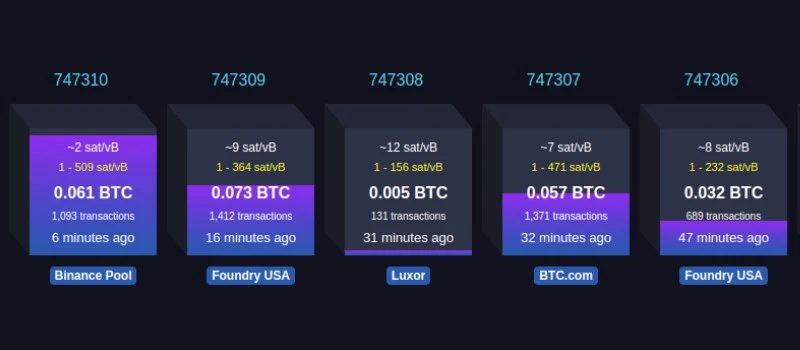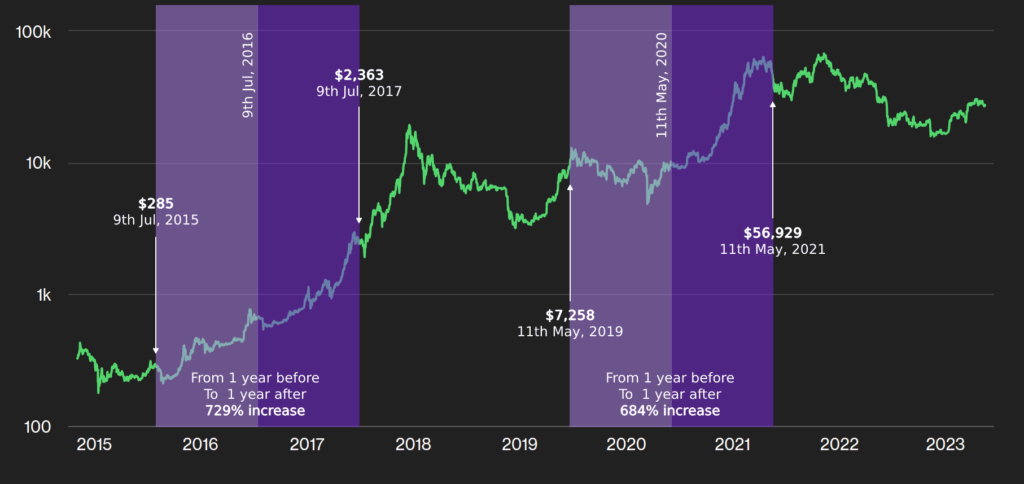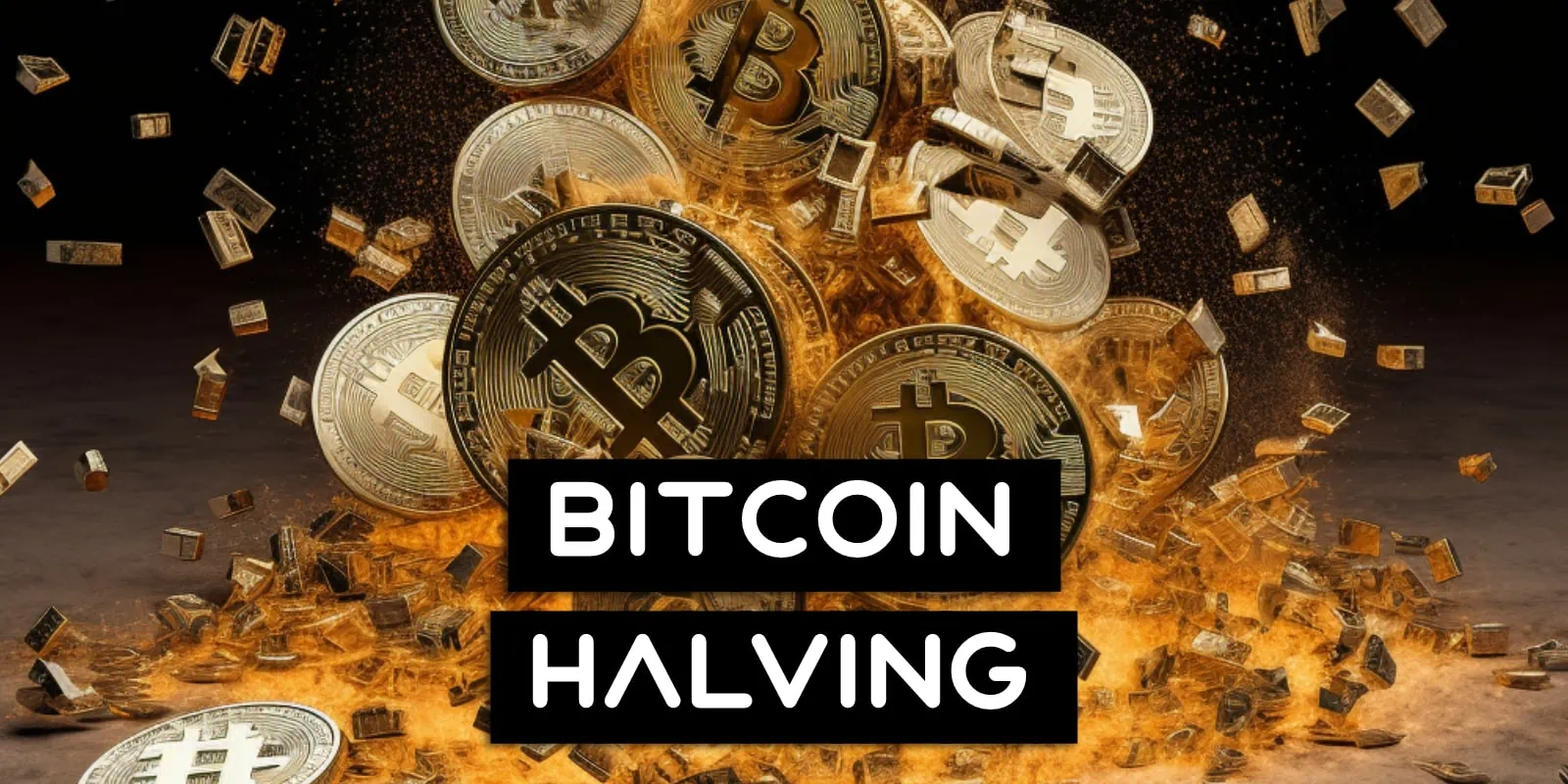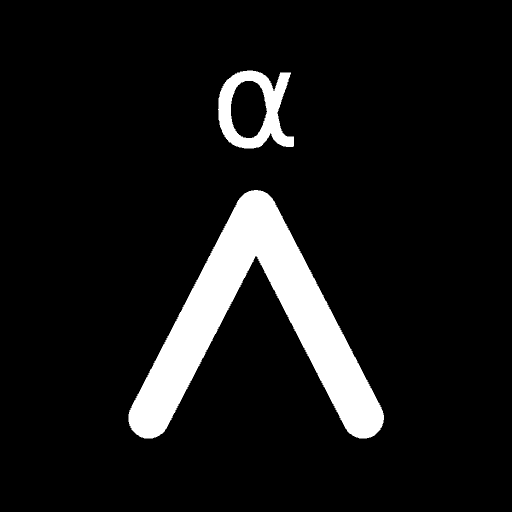The next Bitcoin Halving is a few years away and is estimated to occur in 2028. Maybe you’ve seen posts about previous halvings and others getting excited and don’t really understand why. Well today we’re going to fully explain why it exists and why people celebrate it like it’s Christmas (hint: it usually makes everyone tons of money!)
Contents
What Is Bitcoin Halving?
The Bitcoin Halving (also called Bitcoin Halvening) is when the block subsidy that’s rewarded to Bitcoin miners is halved. Currently in the block subsidy is 3.125 BTC, but in 2028 it will reduce to 1.5625 BTC once the Bitcoin Blockchain hits a block height of 1,050,000.
The day of a Bitcoin halving is tracked and celebrated around the world by millions of Bitcoin users as it represents an event that only occurs once every 4 years. There have been three halving days so far, each one occurring after 210,000 blocks have been mined and this tradition will continue until an estimated 2140.
Bitcoin Halving Explained
One of the six key characteristics that makes any money (crypto or otherwise) a good money is scarcity. For example, salt is not scare. There is basically infinite salt in the world and so if a country used salt as their money then everyone would just go mine huge amounts of salt and use it to buy the whole country. As such, it’s not a very good money.
On the other hand, gold is quite scarce. There isn’t very much of it in the world and it’s very hard to mine for and find new gold. This makes it a good “hard” money as no one can easily get large amounts of it.
In order to ensure that Bitcoin had excellent scarcity Satoshi decided to put a hard cap on How Many Bitcoins could ever be created. That cap is 21 million bitcoins, but then they faced another problem, how should they be fairly distributed?
| Fiat | Bitcoin | Gold | |
|---|---|---|---|
| Scarcity | Low | High | Medium |
Why Does The Bitcoin Halving Happen?
The Bitcoin Halvings happen to help ensure a fair, automatic and even distribution of all 21 million bitcoins over time. As time goes on, the amount Bitcoin miners are paid halves every 210,000 blocks (roughly every 4 years).
This means that those who are involved in the network and help mine it earlier on are rewarded much more than those that come later. The reward can also be claimed by anyone, anywhere just by participating in Bitcoin mining which helps distribute the bitcoins far and wide.
Dive Deeper: What Is Bitcoin Mining?
New to Athena Alpha? Start today!
Why Does It Matter?
When creating a new network, one of the core problems is how to bootstrap it. That is, how do you get people to use it when it’s not actually that useful at the start. This is because the utility of a network like Bitcoin grows as more people use it. This is called the Network Effect.
For example, it’s not hard to convince someone to use the Internet now that there’s billions of people using it. However if there were only 5 random people using it… well it wouldn’t really be much fun would it! The Bitcoin halving helps to encourage people to become Bitcoin Miners earlier on as they get a much larger reward.
As each halving occurs, it also changes the amount of inflation in the Bitcoin ecosystem. Currently the Bitcoin money supply increases or inflates at a rate of around 0.8% p.a. That’s a lot better than the current inflation rates we’re seeing across the world with fiat currencies, but once the next halving hits it’ll be reduced even further to around 0.4%.
How Does The Bitcoin Halving Work?
The Bitcoin Halving works by automatically cutting the Block Subsidy amount in half after 210,000 blocks. This is done by the Bitcoin Core code that is run on all Bitcoin Full Nodes and there is nothing that holders of bitcoins need to do.
Bitcoin’s pseudonymous creator, Satoshi Nakamoto decided to fairly distribute the 21 million bitcoins by steadily rewarding it to Bitcoin Miners who help operate the network with the Block Reward.
The Block Reward is paid out to miners that successfully add a new, valid block to the Bitcoin Blockchain and is made up of two parts:
Block Reward = Block Subsidy + Transaction Fees.
The Block Subsidy is freshly minted bitcoins that are added to the network as part of the reward for miners doing Proof-of-Work (PoW). The transaction fees are just what people are paying to have their transactions included in the block and are already existing bitcoins.
When Bitcoin first started, the Block Subsidy was 50 BTC. Each time someone mined a new block, they would get all the transaction fees and the ability to spend 50 new bitcoins. As you can see, this is a huge incentive and a much bigger reward than what miners get now.
Bitcoin Halving Dates
Although we humans measure time with calendar days, dates and years, Bitcoin is a bit different. It measures time in blocks. One block is mined roughly every 10 minutes on average and so 210,000 blocks is about 4 years.
210,000 Blocks * 10 Minutes = 21,000,000 Minutes = 35,000 Hours = 3.9927 Years
While one block is mined on average every 10 minutes, it’s not always exactly every 10 minutes. As you can see below in this random selection of mined blocks, the first block was mined after 6 minutes, the second after 16 minutes and so on.

This means that the next BTC halving date isn’t known until it happens. When block 1,050,000 is mined we’ll have the exact time and date for the 2028 Bitcoin halving, but until then we can only give a rough estimate.
When Is The Next Bitcoin Halving?
There have been four BTC halving dates so far with the next BTC halving date estimated to happen in 2028.
Historic & Future Bitcoin Halving
Below are the historic and future Bitcoin halvings. As you can see, they occur every 210,000 blocks and will continue until around 2140 which will be the last Bitcoin halving. After this, the Block Subsidy will be reduced to 0 and the Block Reward will be entirely made up of just transaction fees.
| Halving | Era | Block Height | Block Subsidy | Date |
|---|---|---|---|---|
| 2009 | 0 (Genesis Block) | 50.00000000 BTC | 3rd Jan, 2009 | |
| 1 | 2012 | 210,000 | 25.00000000 BTC | 28th Nov, 2012 |
| 2 | 2016 | 420,000 | 12.50000000 BTC | 9th Jul, 2016 |
| 3 | 2020 | 630,000 | 6.25000000 BTC | 11th May, 2020 |
| 4 | 2024 | 840,000 | 3.12500000 BTC | 20th Apr, 2024 |
| 5 | 2028 (est) | 1,050,000 | 1.56250000 BTC | |
| 6 | 2032 (est) | 1,260,000 | 0.78125000 BTC | |
| 7 | 2036 (est) | 1,470,000 | 0.39062500 BTC | |
| 8 | 2040 (est) | 1,680,000 | 0.19531250 BTC | |
| 9 | 2044 (est) | 1,890,000 | 0.09765625 BTC | |
| 10 | 2048 (est) | 2,100,000 | 0.04882813 BTC | |
| 11 | 2052 (est) | 2,310,000 | 0.02441406 BTC | |
| 12 | 2056 (est) | 2,520,000 | 0.01220703 BTC | |
| 13 | 2060 (est) | 2,730,000 | 0.00610352 BTC | |
| 14 | 2064 (est) | 2,940,000 | 0.00305176 BTC | |
| 15 | 2068 (est) | 3,150,000 | 0.00152588 BTC | |
| 16 | 2072 (est) | 3,360,000 | 0.00076294 BTC | |
| 17 | 2076 (est) | 3,570,000 | 0.00038147 BTC | |
| 18 | 2080 (est) | 3,780,000 | 0.00019073 BTC | |
| 19 | 2084 (est) | 3,990,000 | 0.00009537 BTC | |
| 20 | 2088 (est) | 4,200,000 | 0.00004768 BTC | |
| 21 | 2092 (est) | 4,410,000 | 0.00002384 BTC | |
| 22 | 2096 (est) | 4,620,000 | 0.00001192 BTC | |
| 23 | 2100 (est) | 4,830,000 | 0.00000596 BTC | |
| 24 | 2104 (est) | 5,040,000 | 0.00000298 BTC | |
| 25 | 2108 (est) | 5,250,000 | 0.00000149 BTC | |
| 26 | 2112 (est) | 5,460,000 | 0.00000075 BTC | |
| 27 | 2116 (est) | 5,670,000 | 0.00000037 BTC | |
| 28 | 2120 (est) | 5,880,000 | 0.00000019 BTC | |
| 29 | 2124 (est) | 6,090,000 | 0.00000009 BTC | |
| 30 | 2128 (est) | 6,300,000 | 0.00000005 BTC | |
| 31 | 2132 (est) | 6,510,000 | 0.00000002 BTC | |
| 32 | 2136 (est) | 6,720,000 | 0.00000001 BTC | |
| 33 | 2140 onward | 6,930,000 onward | 0.00000000 BTC |
How Does The BTC Halving Impact Price?

Bitcoin Halving cycles have had a distinct influence on Bitcoins price, all of them hugely positive.
The reason for this is actually pretty basic. When the halving happens the supply of new bitcoins that are available reduces by half instantly. This huge reduction in supply happens while the demand for bitcoins stays basically the same. Economics 101 states that if supply is reduced while demand is kept the same, prices will increase.
While the actual day of the halving isn’t usually anything to write home about price wise, it’s clear from the past two that when you zoom out a bit there’s a huge price appreciation that has happened every time. Will this happen again in 2028? No one can say, least of all us, but it seems like a reasonable theory.
FAQ
What Happens When Bitcoin Halves?
When Bitcoin halves, the size of the Block Subsidy that is paid to miners is cut in half. This happens every 210,000 block or about every 4 years.
Why Are The Halvings Occurring Less Than Every 4 Years?
Bitcoin Halving happens every 210,000 blocks. Because a block is mined on average every 10 minutes, this means it happens every 21,000,000 Minutes = 35,000 Hours = 3.9927 Years.
What Date Was Bitcoin Halving?
The 1st Bitcoin Halving was on the 28th Nov, 2012. The 2nd Bitcoin Halving was on the 9th Jul, 2016. The 3rd Bitcoin Halving was on the 11th May, 2020. The 4th Bitcoin Halving was on the 20th April, 2024. The 5th Bitcoin Halving is estimated to happen sometime in 2028.
Will Bitcoin Go Up Or Down After Halving?
No one can say, least of all us. However, the past three halvings have resulted in Bitcoins price increasing steeply over the year after the Bitcoin Halving day occurred.
Who Chose The Bitcoin Distribution Schedule?
Bitcoin’s pseudonymous creator, Satoshi Nakamoto was the one who chose the Bitcoin distribution schedule. When they wrote the original Bitcoin Core code base, it was encoded into it and has never been changed since.



